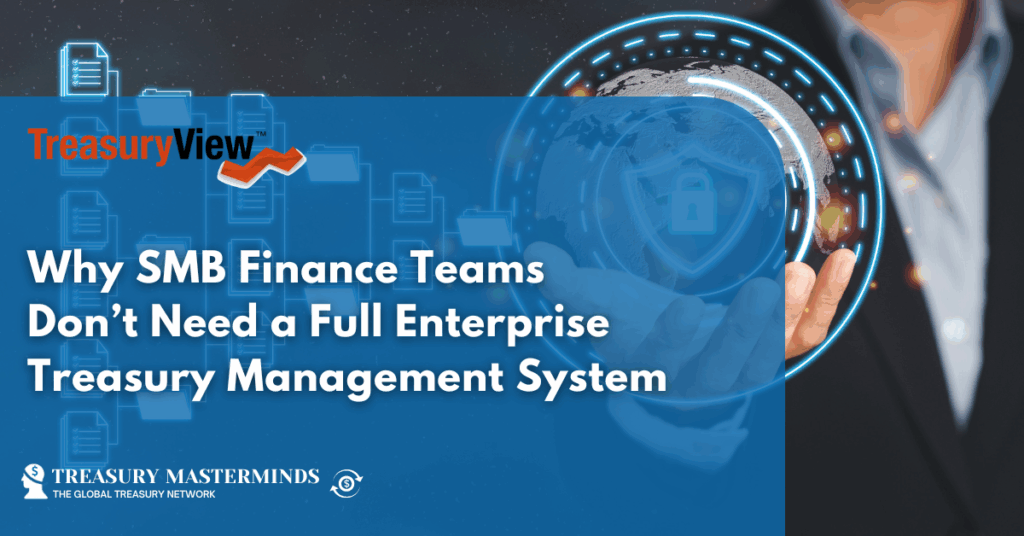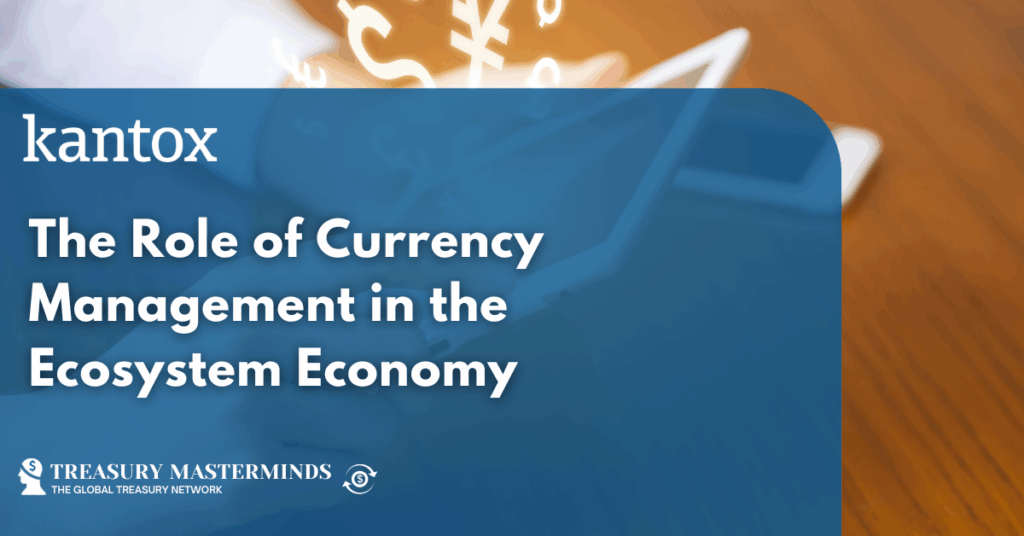
Why SMB Finance Teams Don’t Need a Full Enterprise Treasury Management System
This article is a contribution from our partner, TreasuryView TL, DR Enterprise Treasury Management Systems (TMS) are designed for multinationals managing global cash pools, hundreds of bank accounts, and complex derivatives. For SMBs with €10M–€500M in loans, these systems are overbuilt, costly, and slow to implement. What SMB finance teams need is visibility, automation, and audit-ready reporting. Modern cloud solutions like TreasuryView provide the control and insights SMBs need in days, without the enterprise baggage. The Visibility Myth: Bigger, Entreprise Systems Aren’t Always Better When SMB finance teams begin struggling with Excel: manual reconciliations, version errors, and late-night reporting, many assume the next step is an enterprise TMS. These platforms promise total visibility across debt, liquidity, and risk. But visibility isn’t about the number of features; it’s about having the right features for your team size and complexity. For SMBs, enterprise solutions often add unnecessary cost and operational burden while still leaving day-to-day needs unmet. Why Enterprise TMS Doesn’t Fit SMB Needs 1. Costly Systems to Buy and Maintain for SMBs Enterprise TMS solutions are built and priced for global corporations. Licensing alone can run into hundreds of thousands of euros annually, with additional spend required for consultants, custom integrations, and ongoing IT support. All the investment and binding contracts also make it hard to leave the For SMBs managing €10M–€500M in loans, this level of overhead diverts capital away from growth and liquidity management. 2. Painfully Slow Implementation while SMB finance teams need solution fast Enterprise TMS deployments are notorious for being complex IT projects. A full rollout can take 6–12 months, requiring ERP integrations, vendor workshops, and training. During this time, reporting inefficiencies remain unsolved, often worsen. SMBs, however, need visibility today, not next year. With TreasuryView, onboarding takes less than a day with sign up less than <1 min, with no IT involvement. 3. Over-Engineered Treasury Features that SMBs Never Need/Use Enterprise systems shine in costly areas like cash management, payment management, and Liquidity Management – tools that few SMBs ever need. Most SMBs simply need a clear debt dashboard, automated maturity reporting, and accurate interest cost forecasting. Paying for advanced modules you’ll never use wastes both budget and team capacity, needless to tell the onboarding time that it saves and how more simple and intuitive software is to use. 4. Operational Burden Running an enterprise TMS requires specialized staff, hourse of training… For a lean SMB team, where the CFO and controller often wear multiple hats, this creates an impossible workload. In practice, many SMBs end up reverting back to Excel while their costly TMS sits underused. TreasuryView eliminates this friction with an intuitive, spreadsheet-like interface that requires no treasury expertise or IT background. Human support is always available for a quick call – no IT ticket and talking with AI. The SMB Finance Team’s Reality: Lean Teams, Complex Portfolios SMB finance teams face serious treasury challenges, especially since managing debt and treasury in spreadsheet, is risky: The real constraint isn’t sophistication — it’s time and bandwidth. Excel creates risk; enterprise TMS adds complexity. SMBs need the middle path: fit-for-purpose visibility without enterprise overhead. What SMBs Actually Need in a TMS Alternative The right treasury platform for SMBs should focus on essentials: These capabilities cover 95% of SMB treasury needs without the cost, delay, or operational burden of an enterprise TMS. When (Rarely) an Enterprise TMS Makes Sense An enterprise TMS may be justified if your company is: Conclusion: SMB Finance team, Don’t Overbuy Complexity! Enterprise TMS platforms are designed for multinationals with large treasury teams. SMBs need visibility, automation, and compliance without complexity. Also Read Join our Treasury Community Treasury Mastermind is a community of professionals working in treasury management or those interested in learning more about various topics related to treasury management, including cash management, foreign exchange management, and payments. To register and connect with Treasury professionals, click [HERE] or fill out the form below to get more information. Notice: JavaScript is required for this content.

The Role of Currency Management in the Ecosystem Economy
This article is written by Kantox As financial services are more and more embedded into platforms that provide a one-stop shop experience for clients, there are still gaps where currency management can bring great value. Discover the role of currency management in the realm of fintechs and how it can shape the ecosystem economy. The breakneck performance of leading technology stocks this year is widely attributed to macroeconomic factors such as receding inflation expectations and a pause in short-term interest rate increases in the United States. But here’s another possible explanation: investors are rallying —no pun intended— around the new Ecosystem Economy. This emerging ‘Ecosystem Economy’ is analysed in a book by Venkat Atluri & Miklós Dietz. The Ecosystem Economy. How to Lead in the New Age of Sectors without Borders. According to the authors, the barriers between traditional sectors of the economy are coming down. Instead, large platform companies are reorganising traditional sectors by focusing, like never before, on technology-empowered customers. These (impatient) consumers are now firmly in command. Wherever they go, they seek one-stop shopping experiences to satisfy their changing and ever-expanding needs. All in all, Atluri and Dietz estimate $80 trillion in revenue flowing to small, medium and large ecosystem players in the coming decade or so. This exciting scenario is filled with opportunities for fintech companies as they find their place in the new economic landscape. The emergence of global ecosystems Global ecosystems, according to the authors, will be centred around two types of needs. On the one hand, individual human needs will be addressed in areas like Travel, Home, Commerce, Talent, Mobility and Wealth. On the other hand, B2B services like SMEs and Enterprise services will also be targeted. The companies involved will act either as large ‘ecosystem orchestrators’ or as smaller partners/competitors. Take the so-called Home ecosystem. This area is already operating through platforms that include real estate and rental search engines and online services for inspection, appraisal, moving, renovation, legal issues, decoration and maintenance. Needless to say, this one-stop shopping experience is incomplete without financial services like financing and insurance. As financial services become embedded into most ecosystem platforms, a broad process of ‘fintechisation’ is gaining ground. It will only gather momentum. Astute participants will identify ‘ecosystem gaps’ and move to fill them. Here’s one such gap: currency management. Let’s analyse the role of currency management in this ecosystem economy that is taking shape. The role of currency management Consider the following ‘ecosystems’, and how automated currency management can help fintechs play a decisive role: Enterprise sector: Services to large companies encompass M&A, treasury management, treasury technology infrastructure, long-term funding, strategy consulting and risk management. ⇒ Potential FX-related improvement: in-house FX services to optimise currency management between headquarters/subsidiaries, including netting opportunities. Small and Medium-sized companies: Neobanks are serving the financial needs of micro-businesses and SMEs by offering business cards, invoice management, expense management and bookkeeping and recording. ⇒ Potential FX-related improvement: seamless FX markets operations in different currencies with easy implementation via APIs. Travel: Participants are scrambling to bring many different customer needs—flights, hotels, conferences, events, tickets and others—under one place. Increasingly, this involves embedded financial solutions like payments, insurance, rentals and financing. ⇒ Potential FX-related improvement: embedded SWIFT and SEPA international payments in dozens of currency pairs. Commerce: Retail purchasing needs are increasingly addressed through ‘buy now pay later’ (BNPL) solutions and digital marketplaces with goods and services offered in seamless packages of payments solutions, consumer loans and loyalty programmes. ⇒ Potential FX-related improvement: guaranteed FX markets rates during predetermined time lapses. A broad reorganisation There are, quite obviously, a number of risks involved in the emerging global ecosystem economy. One such risk stems from unnerving geopolitical developments and their potential implications in terms of ‘de-risking’, supply chain disruption and broad changes in the regulatory environment. If, however, the business reorganisation centred around the customer proceeds along the lines suggested by the authors of the Ecosystem Economy, there would be opportunities for fintech companies to cover the financial aspects of the immense range of offerings that will be on display. And, like it or not, we live in a multi-currency world. In other words, ‘fintechisation’ goes hand in hand with automated currency management solutions.The time to act is now. Also Read Join our Treasury Community Treasury Masterminds is a community of professionals working in Treasury Management or those interested in learning more about various topics related to Treasury Management, including Cash Management, foreign exchange management, and Payments. To register and connect with Treasury professionals, click [HERE] or fill out the form below to get more information. Notice: JavaScript is required for this content.